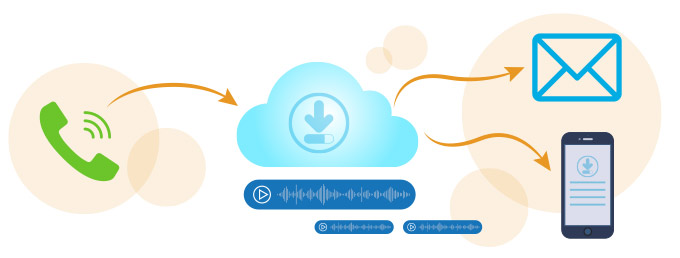Virtual call center software can help you expand your business’ reach, attract and retain more customers, and improve your outbound calling strategy. And it does all of this while keeping your monthly bill low. Here is a comprehensive guide to virtual call center software, it’s benefits, and how to choose the perfect type for your needs.
What is Virtual Call Center Software?
Virtual call center platforms help connect agents and employees from different locations or offices. Such a software makes remote working and work-from-home a possibility. Virtual call center software generally uses VoIP technology and virtual phone numbers to enable inbound and outbound calling regardless of agents’ locations.
Voice over IP technology makes it possible to send voice and video messages through the internet. This way, you are not bound to your landline and location to make and place calls. As long as you have an internet connection, you can route calls to any device of your choice (smartphone, computer, laptop, tablet, etc).
With this ability, your call center and its agents can operate from anywhere in the world while still offering high-quality service.
Call Center Software: On-Premise vs Virtual
So, why should you consider a virtual call center software instead of on-premise call center software? Here is a table to highlight the key advantages of going virtual instead of on-premise:
|
Virtual |
On-Premise |
| Location needs |
Call can be placed and answered from any location |
Calls can be placed and answered from the main office only |
| Scalability |
Flexible |
Static |
| Hiring |
Flexible |
In-house IT team required |
| Office expenses |
Low to zero costs due to remote working and telecommuting |
Office space, desks, chairs, laptops, computers, desk phones, etc. |
| Agent turnover rate |
Low agent turnover rate |
30-45% agent turnover rate (US) |
| Communication features |
Access to virtual communication features in one platform; call recording, outbound calling, automated IVR, etc. |
Limited access to communication features; call transfer, extensions, voicemail, etc. |
Elements of a Virtual Call Center Software
What does a virtual call center software offer users? The purpose of a virtual or cloud-based software is to create and maintain reliable connections from any location. Here are some key elements of virtual call center platforms:
1. Handle Calls from Any Location
With such a software, your business is accessible from any location and is not limited to one specific geographical area. Remote workers and traveling agents will benefit from this the most. Additionally, if you have employees in different states or countries, you can offer customer support to more time zones. Customers in those states and countries can receive service during the times most convenient for them.
2. Offer Global Support
With virtual phone numbers, you can get local or international toll free phone numbers for more than 170 countries across the world. This way, you can offer your services to more businesses beyond your state and country and increase profits. And if you hire agents in these areas, they can offer real-time support to locals.
3. Use Outbound Calling to Connect with Local and International Customers
Outbound calling is a service that uses VoIP technology to enable local and long-distance calling for inexpensive rates. Instead of paying international calling fees, you will be paying your monthly subscription. Furthermore, with the dynamic caller ID feature, outbound calls can display specific local or toll free numbers to increase the chances of recipients answering or returning calls.
4. Use Automatic and Intelligent Call Routing
Use an interactive voice response or IVR system to route and direct calls based on a variety of rules or strategies. This way, incoming calls move to the right department or employee, saving time and improving the caller experience.
5. Record Business Calls
A cloud-based call recording software is capable of recording up to 100% of all incoming and outgoing calls. Depending on the type of business you run, you can use these recordings to:
- Train new employees
- Conduct performance reviews
- Define company standards
- Protect against business or personal liability
- Resolve misunderstandings, and so on
6. Improve Customer Experience and Satisfaction
Excellent customer experience is extremely crucial to your business’ overall growth. If current customers aren’t happy with the service they receive, they will look for a better service elsewhere. It is therefore recommended to use a virtual call center software with advanced communication tools to enhance caller experience. Such a software can help reduce wait times, transfer callers to the right department, offer 24/7 customer service through different channels, and more.
7. Keep Track of Important KPIs
The best way to manage call center performance is by tracking relevant key performance indicators (KPIs). Call center KPIs include:
- Average response time
- Average handle time
- Customer satisfaction (CSAT)
- First call resolution (FCR)
- Percent of abandoned calls, and more
These KPIs can help you, as the manager, identify how each agent or employee is performing and where they need to improve.
8. Offer Multi-Channel and 24/7 Customer Support
The most attractive feature of virtual call center software is its ability to offer not only voice but other forms of communication as well. You can offer phone, email, live chat, troubleshooting help via IVR, and more. With live chat, chatbots, and an informative IVR system, you can also provide customer support 24/7 by routing calls to different offices or by using pre-recorded and automated messages to assist callers/users.
5 Top Reasons to Switch to Virtual Software
A virtual call center platform offers a wide range of features to enhance business communications. And it does so without increasing hardware costs. Here are the reasons why your business should consider getting such a software:
1. Greater Efficiency and Lower Costs
Virtual call center software does not include excessive hardware or installation. Plus, you do not need a specialized IT team in-house to maintain the system. Furthermore, since it works virtually, you can choose to have a small office space and have employees work from home or remotely. All of this helps cut down costs while maintaining efficiency and productivity.
2. Offer Work-From-Home Flexibility
You can offer employees the option to work from home. This broadens your hiring pool and helps you expand not just your staff but your business’ reach. You can have multiple remote workers in different time zones and offer extended customer service hours. Additionally, with growing work-from-home trends, you’ll be providing your employees with a flexible and comfortable work lifestyle that helps with retention and motivation.
3. Set Up New Centers Quickly with Low Costs
Furthermore, if you want to add or set up new centers, you do not have to worry about getting new phone lines or purchasing additional hardware. You can set up new offices quickly and simply have calls routed to the new location, keeping your existing numbers and lines.
4. Gain Access to a Multitude of Virtual Communication Features
With virtual call center software, you have access to voice calls, video conferencing, SMS/instant messaging capabilities, and more. This gives you the opportunity to offer better customer service in ways that customers and prospects will appreciate.
5. Improve Employee/Agent Satisfaction
Finally, with easy-to-use software and flexible work options, you will be increasing employee/agent satisfaction. This is essential to training call center agents and motivating them to continue to do a good job.
How to Choose the Ideal Virtual Call Center Software?
When choosing the perfect call center software, consider the following factors and look for a virtual call center platform that:
1. Is Easy to Set Up and Use
When researching various software and virtual phone system providers, pay attention to the software’s ease-of-use. Is it too complex? Would the complexity hinder use and performance? Global Call Forwarding’s virtual communication system is quick to set up and use. You don’t have to worry about extra hardware to purchase or install. And you can train new employees to use the software within minutes.
2. Comes Equipped with Relevant Features
Virtual communication features are an important aspect of any virtual call center software. However, not all features may be relevant to your needs. Determine what features you need and which would be good additions. We offer the following features:
- Multiple virtual phone number types (toll free, local, and international numbers)
- Call forwarding and routing options
- Call recording
- Outbound calling (with dynamic caller ID)
- Interactive voice response (IVR system)
- Unlimited extensions
- Call transfer
- SIP trunking, and more.
3. Helps You Cut Down Communication Costs
With a VoIP phone system, you can cut down on costs while still expanding your business and entering it in international markets. Therefore, look for a software provider that can give you the global reach you desire. List down the cities, markets, and areas you want to target and find a provider that offers you communication solutions for these areas within a reasonable budget.
4. Offers Reliable and Quality Service
Additionally, you want to choose a provider that has had some experience and credibility in the industry. See how long providers have been in the market and what customer reviews and testimonials are saying about the service. Is this a service you can rely on? If you’re not sure, can you easily get out of the service or is it contract-based?
5. Has a 24/7 Customer Support
Finally, look for a provider that offers 24/7 customer support, whether it is phone, email, live chat, trouble tickets, or an online knowledge base to assist you with issues. A provider should be easily accessible and reachable whenever you need them.
Get Virtual Communication Solutions with Global Call Forwarding
Want to learn about our virtual call center solutions? Call us at 1 (888) 908 6171 or chat with us online to see how we can help improve your business phone system today.










